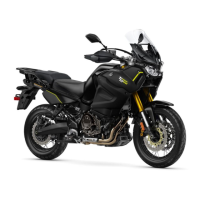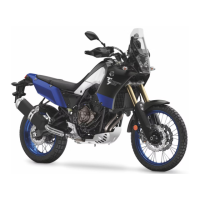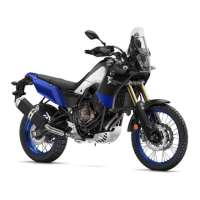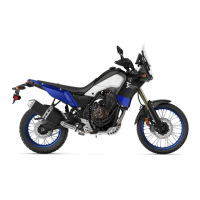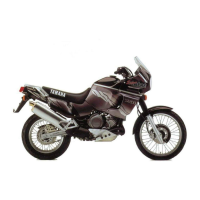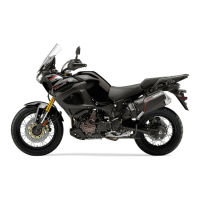Do you have a question about the Yamaha Super Tenere ES 2020 and is the answer not in the manual?
Read the manual and riding tips booklet carefully before operating the motorcycle.
As the vehicle’s owner, you are responsible for the safe and proper operation of your motorcycle.
Perform pre-operation checks to ensure safe operating condition.
Guidelines on wearing appropriate apparel to prevent injuries during accidents.
Information on the dangers of carbon monoxide from engine exhaust and how to avoid exposure.
Guidelines for adding accessories or cargo to maintain stability and avoid accidents.
Choosing accessories designed, tested, and approved by Yamaha for your vehicle.
Risks associated with aftermarket parts and modifications that change vehicle design or operation.
Instructions to follow before transporting the motorcycle in another vehicle.
Diagram showing the left side of the motorcycle with numbered parts.
Diagram showing the right side of the motorcycle with numbered parts.
Diagram of the handlebar and dashboard controls with numbered components.
Description of the main switch positions (ON, OFF, LOCK, P) and how to operate them.
Explanation of various indicator lights on the instrument panel.
Indicates low engine oil level. Replenish oil immediately to prevent damage.
Indicates the status of the Anti-lock Braking System.
Explanation of the cruise control system's operation and speed limitations.
Steps to activate and set the desired cruising speed using the cruise control system.
Overview of the multi-function meter unit and its equipped functions.
Displays engine speed in RPM. Includes a notice about the high-r/min zone.
Indicates the amount of fuel in the tank. Explains low fuel warnings and flashing segments.
Shows the current transmission gear and neutral position.
Indicates the selected drive mode: Touring (T) or Sports (S).
How to adjust the grip warmer temperature settings.
Shows the total distance traveled by the vehicle.
Approximate distance that can be traveled with remaining fuel.
Shows the temperature of the coolant. Warns about overheating.
Allows setting, selecting, or resetting items in the information display.
How to adjust the brightness level of the multi-function meter unit.
Information about the self-diagnosis device and error codes.
Explanation of the D-mode system with Touring (T) and Sports (S) modes.
Diagram and explanation of the left and right handlebar switches.
How to use the switch to start or stop the engine.
Location and operation of the clutch lever, including lever position adjustment.
Location and operation of the brake lever, including adjustment and UBS details.
Explanation of how the unified brake system applies front and rear brakes.
Explanation of the Anti-lock Brake System, its operation, and warnings.
How the traction control system helps maintain traction and its modes (TCS 1, TCS 2, OFF).
How to open and close the fuel tank cap, with a warning about fuel leaks.
Information on fuel requirements, tank capacity, and refueling safety precautions.
Information about the catalytic converter and warnings regarding the hot exhaust system.
How to remove and install the rider seat.
How to adjust the rider seat height to one of two positions.
How to change the windshield height to one of four positions.
Information on adjusting front fork and rear shock absorber preload and damping.
Explanation of damping force settings (HARD, STD, SOFT) and levels.
Information on the standard and additional carriers, including maximum load.
How to use the 12-V accessory jack for powering devices.
Location and operation of the sidestand, and its relation to the ignition cut-off system.
System preventing in-gear starts and stopping engine if sidestand is lowered.
Checks for fuel level, line, and tank breather/overflow hoses.
Checks for oil level, adding oil, and oil leakage.
Checks for operation, fluid level, pads, and hydraulic system leakage.
Checks for operation, fluid level, pads, and hydraulic system leakage.
Checks for damage, tire condition, tread depth, and air pressure.
Checks operation of instruments, lights, signals, and switches.
Conditions required for starting the engine and the starting procedure.
How gears control engine power for starting, acceleration, and climbing.
Steps for engaging the clutch, shifting to first gear, and accelerating.
Important period for engine wear and polishing, with guidelines for the first 1600 km.
Procedure for parking the vehicle safely, with warnings about hot components and slopes.
Importance of maintenance for safety and efficiency, and how intervals may vary.
Location of the tool kit and its intended use for maintenance and minor repairs.
Chart detailing maintenance items and intervals for emission control systems.
Chart detailing general maintenance and lubrication items and intervals.
How to check spark plugs, their condition, gap, and replacement.
How to check the engine oil level and quantity.
Step-by-step guide to changing the engine oil and oil filter cartridge.
How to check the coolant level and change the coolant.
Importance of checking and adjusting valve clearance for engine health.
Essential for safety; maintain tires in good condition and replace when necessary.
How to check and adjust tire air pressure for safe operation.
How to inspect tires for damage, tread depth, and sidewall condition.
Points for maximizing performance and safety of spoke wheels.
How to check for free play at the brake lever end.
How to check front and rear brake pads for wear.
How to check brake fluid level and replenish if necessary, with precautions.
When to change brake and clutch fluids, oil seals, and hoses.
How to check and lubricate brake and shift pedal pivots.
How to check and lubricate centerstand and sidestand pivots.
How to check the condition and operation of the front fork.
How to check for worn or loose steering bearings.
How to check front and rear wheel bearings for play or smooth turning.
Information about the VRLA battery, lead connections, and safety precautions.
How to charge the battery, noting VRLA specific chargers.
How to replace blown fuses, with warnings about amperage ratings.
How to replace a burnt-out headlight bulb, with care instructions.
How to replace a burnt-out bulb in the auxiliary lights.
Information on LED turn signal and brake/tail lights.
General advice on troubleshooting and using genuine Yamaha parts.
Procedure for dealing with engine overheating, including radiator cap safety.
Advice on cleaning matte finished parts to avoid scratching or damage.
Importance of frequent cleaning for appearance, performance, and inspection.
Detailed steps for washing the vehicle, including precautions for water pressure and specific areas.
Steps for drying, polishing, and protecting the vehicle after washing.
Guidelines for storing the vehicle in a cool, dry place, including fuel stabilization.
Steps for storing the vehicle for 60 days or more, including fuel and engine preparation.
Key dimensions of the motorcycle, such as length, width, height, and wheelbase.
Engine specifications including combustion cycle, cooling, valve train, displacement, and bore/stroke.
Recommended engine oil viscosity grades and API/JASO specifications.
Specifications for the final gear oil type and quantity.
Recommended fuel type, tank capacity, and reserve amount.
Battery model, voltage, and capacity specifications.
Bulb type and wattage specifications for the headlight.
Where to record vehicle ID, engine serial, model label, and key ID numbers.
Location of the VIN and its importance for identification and registration.
Information on ECU storing vehicle data for diagnostics, research, and development.
How to report safety defects to NHTSA and Yamaha Motor Corporation.
Chart to record maintenance intervals, dates, mileage, and servicing dealer.
Details of the limited warranty for new Yamaha motorcycles, including period and exclusions.
Information about Yamaha Extended Service plans for extended coverage.
| Compression Ratio | 11.0:1 |
|---|---|
| Transmission | 6-speed |
| Final Drive | Shaft |
| Tires (Front) | 110/80 R19 |
| Tires (Rear) | 150/70 R17 |
| ABS | Standard |
| Traction Control | Standard |
| Engine Type | Liquid-cooled, 4-stroke, DOHC, 2-cylinder |
| Fuel Delivery | Fuel injection |
| Horsepower | 110 hp |
| Suspension (Front) | 43 mm |
| Brakes (Front) | Dual 310mm discs |
| Brakes (Rear) | 282 mm disc |
| Height | 1, 450 mm |
| Seat Height | 845 mm |
| Rake (Caster Angle) | 28 degrees |
| Fuel Capacity | 23 liters |
| Displacement | 1, 199 cc |

